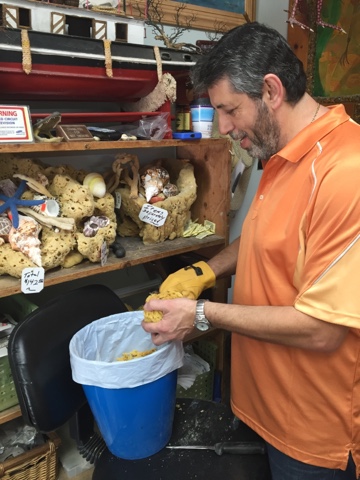This is a typical sponge boat of the original Greek design. This particular boat was retired in 2007 and was used to harvest sponges for 75 years!
We took a ride on an authentic sponge boat to learn more about the process. Max, (the only non-Greek crew member on the boat), wore the historic type of dive suit made of a canvas and rubber sandwich. He wore "shoes" of leather and metal. Below are a few shots of Max retrieving a sponge.
The sponge is an animal. When they are harvested they are covered with a gelatinous substance, which is the actual animal. The sponge as we know it is the skeleton of the organism. Once harvested the sponges are trimmed of rock or coral where they had attached themselves to the sea floor, and are then stacked on deck and covered with burlap, which is kept wet. Periodically the sponges are squeezed, rotated, and re-covered. It takes four days to process the wool sponge, the finest sponge and one found only in the Gulf of Mexico. Our boat captain said the stench is unbelievable! Some of the other varieties of sponge don't take as long to process. Once the soaking process is complete the sponges are cleaned in a peroxide solution and strung on ropes to dry. Merchants buy the strings of sponges and further clean them and cut them into convenient sizes.
One of the Greek shopkeepers was trimming sponges in his shop. He recently moved from Greece, and commented that he had never seen a sponge before arriving here!
There are many shops selling sponges in town.
Following our tours we enjoyed Greek fare, beginning with Saginaki (flaming cheese).
Opa!
(Urban Dictionary: a word that Greek people use for no apparent reason at all!)
Yum!
Please? Maybe a taste of your calamari?














No comments:
Post a Comment
What thoughts do you have?